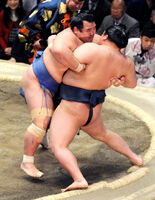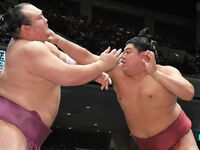Apart from kimarite (winning techniques) there are many techniques that go on during a match that will contribute significantly to a wrestler's win. Many sumo wrestlers have their own unique techniques and preferences.
Deashi (出足): Constant forward movement. Term used to refer to when a wrestler continuously moves forward as opposed to moving backwards or being moved backwards.
Gaburi-yori (がぶり寄り): Pushing the opponent with the torso.
Hazuoshi (筈押し): Pushing up with hands under opponent's armpits. Hazu refers to the nock of an arrow where it makes contact with the bow string. Hazu can also mean the nock-shaped area of the hand between the thumb and forefinger, so in this case means using the hazu of the hand to lock into the armpit of the opponent and push them upward to prevent them from getting a hold of one's belt.
Henka (変化): A sidestep to avoid an attack. If done, it is usually at the tachi-ai to set up a slap-down technique, but this is often regarded as bad sumo and unworthy of higher ranked wrestlers. Some say it is a legitimate "outsmarting" move, and provides a necessary balance to direct force, "henka" meaning "changing; to change".
Inashi (往なし): To sidestep or dodge. As opposed to when done at the tachiai when it is referred to as a henka, inashi is done after the initial tachiai to catch the opponent off guard and force him out in another direction.
Kachi-age (搗ち上げ): Technique where the wrestler folds his arms and rushes forward to hit opponent's chest or chin to make his posture upright. This is most commonly done at the tachi-ai and can also result in stunning the opponent. Literally translates as striking upward. The first kanji character is uncommon and is also the one used to describe polishing rice or pounding mochi cakes.
Kuisagaru (食い下がる): Grabbing the front of the opponent's belt, placing one's head against their chest, and lowering one's hips in an effort to lower one's center of gravity in order to force out an opponent.
Maemitsu (前褌): Front of the mawashi. Often referred to as a maemitsu grip when one has a hold of the front of the mawashi.
Makikae (巻き替え): Changing from an overarm to an underarm grip on one's opponent's belt. If done properly can lead to a speedy victory, however if not done properly will often end in quick defeat.
Matta (待った): False start. When the wrestlers do not have mutual consent in the start of the match and one of the wrestlers starts before the other wrestler is ready, a matta is called, and the match is restarted. Typically the wrestler who is at fault for the false start (often this is both of them; one for giving the impression that he was ready to the other and the other for moving before his opponent was ready) will bow to the judges in apology. The kanji, 待, means to wait, indicating that the match must wait until both wrestlers are ready.
Even though this is not an official technique, some wrestlers will delibretley cause a matta in order to get in his opponent's head. This technique may cause his opponent to lose his original plan or knock him off guard.
Moro-zashi (両差し): Deep double underarm grip which prevents the opponent from grabbing the belt.
Nekodamashi (猫騙し): Clapping of the hands at the tachi-ai to distract the opponent.
Nodowa (喉輪): Thrusting at an opponents throat.
Oshi-zumo (押し相撲): There are two main types of wrestling in sumo: oshi-zumo and yotsu-zumo. Oshi-zumo literally translates as pushing sumo, and is more commonly referred to in English as a Pusher (oshi)-Thruster(tsuki). One who fights in the oshi-zumo style prefers fighting apart, not grabbing the belt as in yotsu-zumo, and usually winning with tactics of pushing, thrusting, and tsuppari. Oshi-zumo when done effectively can lead to a quick and decisive victory, but its exponents often fall prey to dodging motions or being slapped down, and may become helpless once the opponent gets a hold of their belt. Oshi-zumo fighters are generally thought of as simplistic, while yotsu-zumo fighters are seen more as technicians.
Ottsuke (押っ付け): Technique of holding one's opponent's arm to prevent him from getting a hold on one's belt. Literally, "push and affix" as in affixing the opponent's arm against one's body and preventing it from reaching the belt.
Tsuppari (突っ張り): To rapidly deliver harite (張り手 or open hand strikes) to the opponent. This technique is frequently employed by oshi-zumo wrestlers.
Yotsu-zumo (四つ相撲): There are two main types of wrestling in sumo: oshi-zumo and yotsu-zumo. Yotsu-zumo is where both wrestlers grasp the other's belt with both hands, hence the literal translation: four sumo or four hands on the mawashi sumo. There are a few sub-types of yotsu-zumo. Migi-yotsu (右四つ) is when one has sashite (差して) on the right (migi), meaning that one has his right hand under his opponent's left arm and grasping his mawashi. Hidari-yotsu is the opposite where one's left (hidari) hand is inside the opponent's right arm. A yotsu-zumo fighter will typically prefer left or right and is referred to as migi-yotsu or hidari-yotsu fighter. If one has no preference, they are referred to as namakura-yotsu (鈍ら四つ), where namakura literally translates as lazy or cowardly, suggesting that having no preference is seen in a negative light. There is one other final yotsu grip known as moro-zashi (両差し), literally sashite on both sides, where both hands are inside and is a very strong grip. The only real defense for a moro-zashi grip is the kimedashi (極めだし) technique where the defending wrestler wraps both of his arms over the moro-zashi grip and locks his hands underneath, which squeezes the double inside grip together, weakening it, and allowing one to force the opponent out of the ring. Kime-dashi is also known as kannuki (閂, usually written in hiragana as かんぬき), and means to bolt or bar. When two wrestlers who both fight in the yotsu-zumo style oppose each other and favor the same style grip, either migi-yotsu or hidari-yotsu, then they will fit together nicely in what is called ai-yotsu (相四つ), or together yotsu. If however they are of opposite preferences, then it is known as kenka-yotsu (喧嘩四つ), literally fighting yotsu. In this situation, whoever gets his preferred grip is usually the victor.







